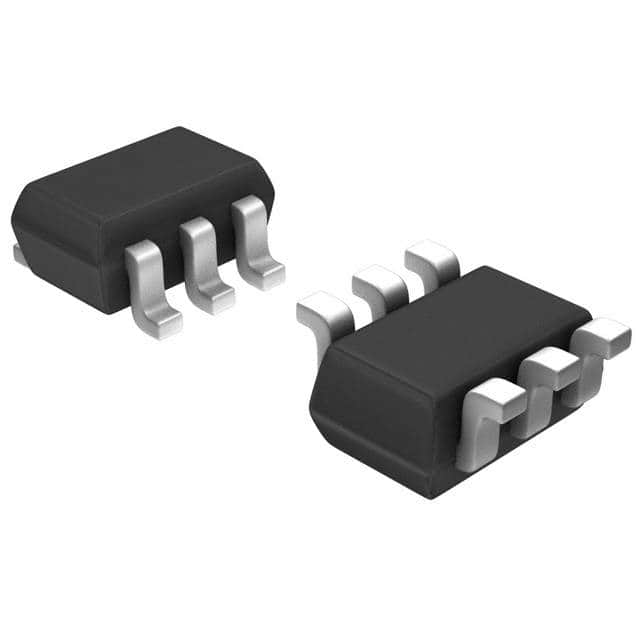Consulte las especificaciones para obtener detalles del producto.

NC7WZ14P6
Product Overview
- Category: Integrated Circuit (IC)
- Use: Logic Gate
- Characteristics: High-speed, low-power consumption
- Package: SOT-363
- Essence: Inverter Schmitt Trigger
- Packaging/Quantity: Tape and Reel, 3000 units per reel
Specifications
- Supply Voltage: 1.65V to 5.5V
- Input Voltage: 0V to VCC
- Output Voltage: 0V to VCC
- Operating Temperature: -40°C to +85°C
- Propagation Delay: 2.5ns (typical)
- Quiescent Current: 10μA (maximum)
Detailed Pin Configuration
The NC7WZ14P6 has a total of six pins:
- GND: Ground reference for the IC.
- A: Input pin for the logic signal.
- Y: Output pin for the inverted logic signal.
- VCC: Positive power supply voltage.
- B: Input pin for the complementary logic signal.
- NC: No connection pin.
Functional Features
- Inverter Operation: The NC7WZ14P6 is designed to perform inverting operations on logic signals.
- Schmitt Trigger: It incorporates a Schmitt trigger input, allowing it to provide hysteresis and improve noise immunity.
- High-Speed Performance: With a propagation delay of only 2.5ns, it enables fast switching times.
- Low Power Consumption: The IC operates with a quiescent current of maximum 10μA, making it suitable for battery-powered applications.
- Wide Supply Voltage Range: It can operate within a wide range of supply voltages, from 1.65V to 5.5V.
Advantages and Disadvantages
Advantages
- High-speed operation enables quick response times.
- Low power consumption prolongs battery life in portable devices.
- Schmitt trigger input enhances noise immunity.
- Wide supply voltage range allows for versatile applications.
Disadvantages
- Limited number of inputs and outputs restricts complex logic operations.
- Small package size may require careful handling during assembly.
Working Principles
The NC7WZ14P6 is an inverter Schmitt trigger IC that converts logic signals. When the input voltage exceeds a certain threshold, determined by the Schmitt trigger, the output switches states. This hysteresis property helps eliminate noise and provides stable output transitions. The IC operates based on complementary metal-oxide-semiconductor (CMOS) technology, which ensures high-speed performance and low power consumption.
Detailed Application Field Plans
The NC7WZ14P6 finds application in various fields, including:
- Digital Systems: It can be used in digital systems for signal inversion and level shifting.
- Communication Devices: The IC is suitable for use in communication devices, such as smartphones and tablets, where it aids in signal processing and data transmission.
- Automotive Electronics: It can be employed in automotive electronics for tasks like sensor interfacing and control signal generation.
- Industrial Automation: The IC can contribute to industrial automation systems by providing logic signal conversion and interfacing capabilities.
Detailed and Complete Alternative Models
Some alternative models to the NC7WZ14P6 include:
- 74HC04: A hex inverter IC with similar functionality but different package options.
- SN74LVC1G04: A single inverter IC with Schmitt trigger input, available in various packages.
- CD40106B: A hex Schmitt trigger IC with inverter functionality, suitable for a wide range of applications.
These alternative models offer similar features and can be used as replacements depending on specific requirements.
Word count: 409 words
Enumere 10 preguntas y respuestas comunes relacionadas con la aplicación de NC7WZ14P6 en soluciones técnicas
Sure! Here are 10 common questions and answers related to the application of NC7WZ14P6 in technical solutions:
Question: What is NC7WZ14P6?
Answer: NC7WZ14P6 is a hex inverter Schmitt trigger IC (integrated circuit) that can be used for signal conditioning and level shifting applications.Question: What is the operating voltage range of NC7WZ14P6?
Answer: The operating voltage range of NC7WZ14P6 is typically between 1.65V and 5.5V.Question: Can NC7WZ14P6 be used for level shifting between different voltage domains?
Answer: Yes, NC7WZ14P6 can be used for level shifting between different voltage domains as it has a wide operating voltage range.Question: What is the maximum output current of NC7WZ14P6?
Answer: The maximum output current of NC7WZ14P6 is typically around 8mA.Question: Can NC7WZ14P6 be used for buffering weak signals?
Answer: Yes, NC7WZ14P6 can be used for buffering weak signals as it provides signal amplification and conditioning.Question: Is NC7WZ14P6 suitable for high-speed applications?
Answer: Yes, NC7WZ14P6 is suitable for high-speed applications as it has a propagation delay of typically 5ns.Question: Can NC7WZ14P6 be used in battery-powered devices?
Answer: Yes, NC7WZ14P6 can be used in battery-powered devices as it operates within a low voltage range and consumes very low power.Question: What is the package type of NC7WZ14P6?
Answer: NC7WZ14P6 is available in a small SOT-363 package, which is suitable for space-constrained applications.Question: Can NC7WZ14P6 be used in both digital and analog circuits?
Answer: Yes, NC7WZ14P6 can be used in both digital and analog circuits as it provides signal conditioning and level shifting capabilities.Question: Are there any alternative ICs to NC7WZ14P6 for similar applications?
Answer: Yes, there are alternative ICs available from different manufacturers, such as 74HC14, CD40106, or SN74LVC1G14, which can be used for similar applications.
Please note that the answers provided here are general and may vary depending on specific application requirements.

